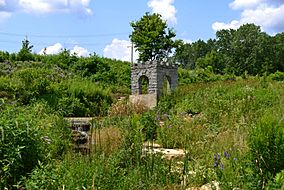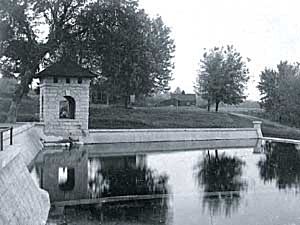Coldwater Spring facts for kids
Quick facts for kids Coldwater Spring |
|
|---|---|
| Mní Ówe Sní | |
|
IUCN Category II (National Park)
|
|

Coldwater Spring in July 2014
|
|
| Location | Fort Snelling unorganized territory in the U.S. state of Minnesota |
| Nearest city | Minneapolis |
| Governing body | U.S. National Park Service |
| Website | Coldwater Spring |
Coldwater Spring (in the Dakota language: Mní Ówe Sní) is a natural spring in Minnesota. It is a very special place for the Dakota people, who consider it sacred. It was also once the site of the U.S. Army's Camp Coldwater. Soldiers stayed here while they built Fort Snelling.
Coldwater Spring is found on the west side of the Mississippi River. It is just south of Minnehaha Park and next to Fort Snelling State Park. Water flows from the spring all year long, even in winter when it stays unfrozen. The National Park Service now takes care of the spring and the land around it. It is a protected historic site and natural park. It is part of the Mississippi National River and Recreation Area.
Contents
Discovering Coldwater Spring
Coldwater Spring has a long and interesting history. It has been important to many different groups of people over time.
First People and the Spring
For hundreds of years, the Dakota people have seen Coldwater Spring as a very important spiritual place. The area where the Mississippi and Minnesota rivers meet was a neutral and sacred spot. Different tribes like the Ojibwe, Dakota, Sauk, Meskwaki, and Potowatamie could move freely here.
Camp Coldwater's Story
Early European-American explorers found the spring area. They were interested in expanding the fur trade. In 1805, this land became part of a large area bought from the Mdewakanton Sioux Indians by Zebulon Pike. It was set aside for military use.
In 1820, Lieutenant Colonel Henry Leavenworth moved his troops to the spring. Their old camp was unhealthy. Colonel Josiah Snelling took over later that year. The soldiers lived in tents and huts near the spring for three summers. During this time, they built the stone fort nearby, which was finished in 1825. This fort was named Fort Snelling. The spring continued to provide water to the fort. First, water was carried by wagons. Later, a stone water tower and underground pipes were built.
Some settlers from the Red River Colony lived near the spring in 1821. But they had to leave in 1840. They moved down the Mississippi River and started the city of Saint Paul, Minnesota. The Coldwater area once had blacksmith shops, stables, trading posts, a hotel, and a steamboat landing. But most of these buildings were gone by the time of the American Civil War.
When Fort Snelling reopened during the Civil War, Coldwater Spring again supplied water to the fort. In the 1880s, the Army built a special water system there. This included the springhouse and reservoir you can still see today.
Mines Research Center
After World War II, Fort Snelling closed. The Coldwater Spring site was then given to the United States Bureau of Mines. It became their Twin Cities Research Center. For over 40 years, mining research happened here. Many buildings were built in the 1960s for over 200 workers.
Researchers at this site made important discoveries. They created a system to clean the air. This helped stop black lung disease in coal miners. They also invented a beeping device to warn people when a heavy truck was backing up. The research center closed in 1996, and some buildings were left empty.
Protecting the Spring from Highways
For many years, people worked to protect the spring. This delayed plans for building a freeway in the area. In 2003, the Minnesota Department of Transportation did something new. They used a special liner to protect the water flow to the spring. This liner covered about six acres. It allowed the highway interchange to stay dry while water flowed underneath it to the spring.
Who Owns the Land?
In 2006, the National Park Service looked at what to do with the abandoned site. If the federal government sold the land, it had to go to a state or local government, an American Indian tribe, or a school. Officials from Hennepin County wanted to turn the site into a business park. But conservationists wanted it to be a public natural park.
Coldwater Spring Park Opens
The land was given to the National Park Service in 2010. It became part of the Mississippi National River and Recreation Area. Plans were made to bring back the native landscape. This led to talks about the Dakota history of the area. The Lower Sioux Indian Reservation officially called Coldwater a traditional cultural property. They stated that the area "has been used for traditional, spiritual, religious and cultural ceremonies by the MN. Mdewakanton and their hereditary descendents [sic] for thousands of years." They also said that "the water of Coldwater Spring has been traditionally utilized for healing of Dakota people and others."
National Park Service teams worked hard at Coldwater Spring. They fixed the springhouse, restored the creek and wetlands, and removed plants that didn't belong. They also took down several old buildings. The area now looks like an oak savanna, similar to how it was before European-American settlers arrived. The National Park Service opened Coldwater Spring park to the public in 2012.
Spring's Geology and Water
Coldwater Spring comes from Platteville limestone rock. This rock is near the river gorge. The gorge was formed over 10,000 years ago by melting glaciers after the last ice age. Water flows from the spring at about 144,000 gallons each day. It stays at 47 °F (8 °C), so it never freezes in winter. You can often see ducks there. The water flows into a reservoir. Then it tumbles into a wetlands waterfall and finally reaches the Mississippi River. The water from Coldwater Spring is not safe to drink.
The Park's Landscape
In 2012, the park was greatly changed. Native grasses and wildflowers were planted to bring back the original oak savanna landscape. This was similar to efforts at the Bruce Vento Nature Sanctuary in Saint Paul. National Park Service staff and volunteers help keep the restored landscape healthy.
Fun Things to Do
Coldwater Spring park has walking paths through a tallgrass prairie. You can also see the natural spring and the historic springhouse and reservoir. There is a .25-mile (0.40 km) crushed limestone path from the entrance. It winds through the restored savanna to the springhouse. Beyond the springhouse, a 1-mile (1.6 km) hiking trail crosses the creek. It goes into the nearby woodlands and connects to the Minnehaha Trail. This trail leads north to Minnehaha Park or south to Fort Snelling State Park. Many visitors enjoy bird watching and seeing other wildlife. The park has limited parking. There is no visitor's center or restroom.
Gallery







